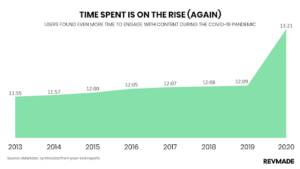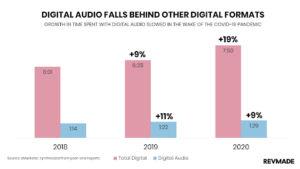Is a podcast right for your brand?
Poor avenues for discovery, big demands on audience attention and dubious ROI make for a marketing challengeRevmade regularly scours the internet for new studies that offer important insights for marketers. Then we write them up for you in as few words as possible. (Want to get them emailed to you? Sign up here.)
A story detailing the Reuters Institute’s predictions for 2022 included a finding that four in five surveyed publishers plan to invest in podcasts and other digital audio this year. Yet when looking at trends relating to podcasts as a medium more broadly, it is difficult to ignore significant challenges relating to audience attention, new podcast discovery, and return on investment. We’re podcast fans ourselves, but we pulled together some stats to take a sober look at the podcast industry today.
It’s a crowded market for podcasts…
There are more podcasts than ever before (Spotify alone hosted more than 3.2 million in 2021). That’s spurred, in part, by the relative ease of audio production. You might scoff at that, but based on our experience, you can get a solid-quality podcast up and running for less than $1,000.
Apple Podcasts and Spotify make up roughly two-thirds of the market, yet one of those thirds comprises dozens of tiny platforms, most of which make up less than 1% of total podcast listens. That’s a problem when it comes to user engagement, as the user experience on these platforms can vary quite a bit (no, not all podcast platforms let you leave a five-star review). But, generally, it’s not too much of a lift to get up and running enough to get your voice (and your brand) heard.
…but there’s only so much attention to go around.
Overall, total audience attention per day is reaching a natural limit – the pandemic was a dramatic pause in a long-term trend of plateauing hours in the day people have to look at and interact with a screen.

And digital formats have steadily cannibalized time spent with traditional media over the last decade. But digital audio, including podcasts, didn’t see a commensurate increase, and eMarketer projects digital audio annual growth in time spent falling to less than 4% in 2022. Last year we saw growth of time spent with digital audio slow down while digital, as a whole, increased its share of audience engagement.

In a media environment where digital audio engagement is plateauing and more and more podcast content is being produced, there’s only going to be so much time that listeners can devote to new podcasts. When browsing the top podcasts of the past year, a significant majority are long-standing ones, with few new ones emerging from the past year.
That should feel right to most podcast listeners. How many new podcasts did you add to your regular rotation last year? It’s a major commitment, given the amount of time you have for podcasts. You’d probably have to give one up to add a new one in, and who wants to give up a podcast they have been listening to for several years? It’s similar to the challenge years ago when apps tried to break into users’ “home screens.” Users have five to 10 apps that they use every day, and it’s nearly impossible to break into that mix.
In the context of reaching “maximum” audience attention, new podcasts need to compete not just against other podcasts, but also against all other potential forms of information and entertainment, and in several ways, podcasts fail to match up against the ease and utility of text and video formats.
You wouldn’t skim a podcast
Text and video formats are more apt for short-form than audio, making it easier to fit an extra short article or TikTok clip into your day. Very few podcasts clock in at less than 15 minutes, let alone the five-minute range that someone might consider listening to on a whim.
Plus, you can quickly browse text or preview still images to skip ahead on YouTube, but you can’t do either very well in audio. Blindly jumping through an episode is a horrible user experience, save for those blessed few podcasts that add time markers to their episode descriptions.
When a podcast shows up in your feed with a three-hour recap of a two-hour Friends special (and then asks for a five-star rating), it’s a huge demand on time and attention in an era when audiences have less of both than ever before.
So are podcasts doomed as a format?
If you’re looking for a panacea for audience engagement goals, you probably won’t find it here. Are you sure your audience wants a new podcast? Or are internal stakeholders selling a story of audience needs that aren’t backed up by actual data and insights?
When we looked at the most successful B2B content formats last month, we found that podcasts fell into the lowest quartile of formats by both frequencies of use and effectiveness against marketing goals. But we still see opportunities for the smart use of podcasts to meet marketer and audience needs, especially in niche areas that tie into an audience’s professional work.
Here are four things to think about if you’re considering a new podcast for your organization:
- Who is your audience, and why are they listening? Tailor your editorial plan for the audience you’re trying to reach, and make sure your editorial plan serves specific audience needs. There simply isn’t enough room in the market for yet another general interest podcast.
- Do they have time for a new podcast? Ask your audience what their podcast habits look like and what they’re looking for in a new podcast. What are they doing while listening? Getting a sense of their media diets will let you know whether there’s room for your new entry and whether you should aim for five-to-10 minute quick-depth episodes or something that should be streamed in a longer sitting.
- Is there space in your market for another entrant? If you find that there just aren’t any podcasts touching on a subject central to your organization, an absence of competition could put you in a good position to capture audiences’ attention.
- Can you prove it’s more effective than other formats? Podcasts are notorious for poor reporting on audience trends. Be sure you have a strategy for measuring whether your podcast is meaningfully engaging audiences better than other content efforts.
TL;DR: New podcasts face stiff headwinds, but with the right audience angle, there’s still room for audio engagement.
Thinking about starting a new podcast? Wondering whether a podcast is right for your audience? We can help.
Subscribe
Get our weekly newsletter for tips on how to drive better content marketing performance.
For a regular stream of ideas, research and links we find helpful. And of course, to say hi!
